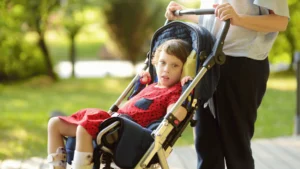Everything to Know about Spastic Diplegia Cerebral Palsy
Introduction: Cerebral palsy is a neurological disorder that affects movement and muscle coordination. Among the different types of cerebral palsy, spastic diplegia is one of the most common forms. It primarily affects the legs and can cause tightness and stiffness in the muscles, hampering physical activities. Understanding the symptoms, causes, and available treatments for spastic diplegia cerebral palsy is essential to provide proper care and support to those affected by this condition.

Overview:
Spastic diplegia cerebral palsy is characterized by muscle tightness and stiffness, primarily affecting the legs. It is caused by damage to the brain’s motor cortex, which is responsible for controlling voluntary movement. This damage disrupts communication between the brain and muscles, making it challenging for individuals with this condition to control their movements effectively.
People with spastic diplegia cerebral palsy often experience difficulty with tasks like walking, maintaining balance, and coordination. While the upper body’s muscles are relatively unaffected, symptoms are most pronounced in the lower extremities. Treatments like physical therapy, medications, and assistive devices can help manage symptoms, improve mobility, and enhance the quality of life for those living with this condition.
Symptoms:
The common symptoms of spastic diplegia cerebral palsy include:
- Tightness and stiffness in leg muscles
- Difficulty with walking or a scissor-like gait
- Poor balance and coordination
- Involuntary muscle contractions or spasms
- Delayed motor milestones (such as sitting or crawling)
If you notice any of these symptoms in yourself or your child, it is crucial to consult a doctor for a proper diagnosis and treatment plan.
Contacting a Doctor:
When it comes to concerns related to cerebral palsy, it is essential to reach out to a healthcare professional who specializes in neurodevelopmental disorders. Your primary care physician or pediatrician can refer you to a neurologist, orthopedic specialist, or developmental pediatrician for a comprehensive evaluation. They will conduct a thorough examination, review your medical history, and may order additional tests such as MRI or CT scans to confirm the diagnosis of spastic diplegia cerebral palsy.
Having a knowledgeable medical team can help guide you through the treatment options, therapies, and necessary support systems for managing spastic diplegia cerebral palsy.
Cause:
The damage to the brain’s motor cortex, leading to spastic diplegia cerebral palsy, is often a result of brain injuries during pregnancy, childbirth, or infancy. The exact cause of brain damage in most cases is unknown, but several risk factors have been identified:
- Premature birth
- Low birth weight
- Maternal infections during pregnancy
- Severe jaundice in newborns
- Oxygen deprivation during birth
It is crucial to note that brain damage can occur due to a variety of factors, and not all children with these risk factors develop spastic diplegia cerebral palsy.
Risk Factors:
There are several risk factors associated with the development of spastic diplegia cerebral palsy:
- Preterm babies have a higher risk, especially those born before 32 weeks of gestation.
- Twins or multiple births are at a greater risk compared to singletons.
- Maternal health conditions like infections, thyroid issues, and clotting disorders can increase the risk.
- Complications during pregnancy, such as placental abnormalities or uterine rupture, can pose a higher risk.
However, it is important to remember that every case is unique, and many individuals with spastic diplegia cerebral palsy have no identifiable risk factors.
Treatment:
While there is no cure for spastic diplegia cerebral palsy, various treatments and therapies can help manage symptoms, improve mobility, and enhance quality of life:
- Physical therapy: Involves exercises and stretching to improve muscle strength, flexibility, and mobility.
- Medications: Muscle relaxants, anti-spasticity drugs, and Botox injections can reduce muscle tightness and improve comfort.
- Orthopedic interventions: Surgeries such as tendon lengthening or selective dorsal rhizotomy can help improve muscle function and joint mobility.
- Assistive devices: Braces, splints, walkers, and wheelchairs can aid in mobility and provide support for daily activities.
Early intervention and consistent therapy significantly improve outcomes for individuals with spastic diplegia cerebral palsy, helping them reach their maximum potential.
Prevention:
While not all cases of spastic diplegia cerebral palsy are preventable, maintaining a healthy lifestyle during pregnancy and seeking proper prenatal care can reduce the risk:
- Regular prenatal check-ups and screenings
- Avoiding exposure to harmful substances like alcohol, tobacco, and illicit drugs
- Managing and treating maternal infections promptly
- Following proper prenatal nutrition guidelines
Prevention strategies may not guarantee avoiding cerebral palsy entirely, but they can reduce the likelihood of certain risk factors that contribute to its development.
Summary:
Spastic diplegia cerebral palsy is a common type of cerebral palsy that primarily affects the legs. It is characterized by muscle tightness and stiffness, making mobility and coordination challenging. While the exact cause is often unknown, premature birth, low birth weight, and maternal infections during pregnancy are some of the common risk factors. Early diagnosis, comprehensive medical care, and a multidisciplinary approach involving physical therapy, medication, and orthopedic interventions can help manage symptoms and improve the quality of life for individuals with spastic diplegia cerebral palsy.
Understanding the various aspects of spastic diplegia cerebral palsy is essential to provide the necessary support and resources to those affected by this condition, ensuring they lead fulfilling lives with optimal mobility and independence.
Disclaimer: This article is for informational purposes only and should not replace professional medical advice. Always consult with a qualified healthcare professional for accurate diagnosis and treatment options.